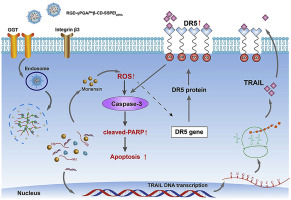Biomaterials ( IF 14.0 ) Pub Date : 2017-12-22 , DOI: 10.1016/j.biomaterials.2017.12.018 Fan Xu , Huihai Zhong , Ya Chang , Dongdong Li , Hongyue Jin , Meng Zhang , Huiyuan Wang , Chen Jiang , Youqing Shen , Yongzhuo Huang

|
Chemoresistance remains a formidable hurdle against cancer therapy. Seeking for novel therapy strategies is an urgent need for those who no longer benefit from chemotherapy. Chemoresistance is usually associated with the dysfunction of intrinsic apoptosis. Targeting extrinsic apoptosis via TRAIL signaling and the death receptors could be a potential solution to treat chemoresistant cancer. A highly biocompatible nano system for codelivery of the TRAIL DNA and the death receptor sensitizer monensin, in which low-molecular-weight PEI (LMW-PEI) was crosslinked by the sulfhydryl cyclodextrin via disulfide bonds, and then bound with DNA, thus forming the bioreducible polyplex cores. In addition, the cyclodextrin also functioned as a carrier for the hydrophobic monensin via host-guest inclusion. Poly-γ- glutamic acid (γ-PGA) was used to modify the polyplex core via charge interaction. The γ-PGA corona can specifically bind with the tumor-associated gamma-glutamyl transpeptidase (GGT) on the tumor cells, and achieve tumor-targeting delivery. Moreover, the tumor-homing peptide RGD-modified γ-PGA was also prepared as surface coating materials for further improving gene delivery. The gene delivery system is characterized by the dual ligand-targeting, dual stimuli-responsive features. The ligands of RGD and γ-PGA can target the tumor-associated receptors (i.e., integrin and GGT). The conformation of γ-PGA is pH-sensitive, and the tumor acidic micro environments could trigger the detachment of surface-coating γ-PGA. The disulfide crosslinking LMW-PEI is redox-sensitive, and its fast disassembling in tumor cells could favor the efficient gene delivery. The anti-tumor efficacy was demonstrated both in vitro and in vivo. Moreover, MYC-mediated synthetic lethality could be an important mechanism for overcoming the drug resistance. An important finding of our studies is the demonstration of the in vivo treatment efficacy of TRAIL/monensin, thus providing a potential novel therapeutic strategy for overcoming drug-resistant cancer.
中文翻译:

针对耐药性癌症治疗的靶向死亡受体:使用双重靶向和刺激反应的自组装纳米复合材料对pTRAIL和莫能菌素进行代码传递
化学抗药性仍然是对抗癌症治疗的巨大障碍。对于那些不再能从化疗中受益的人来说,寻求新的治疗策略是迫在眉睫的。化学抗性通常与固有凋亡的功能障碍有关。通过TRAIL信号传导和死亡受体靶向外源性凋亡可能是治疗化学耐药性癌症的潜在解决方案。用于TRAIL DNA和死亡受体敏化剂莫能菌素代码传递的高度生物相容性纳米系统,其中低分子量PEI(LMW-PEI)通过巯基环糊精通过二硫键交联,然后与DNA结合,从而形成可生物还原的多聚核。另外,环糊精还通过客体-客体包涵体充当疏水莫能菌素的载体。聚-γ-谷氨酸(γ-PGA)被用来通过电荷相互作用来修饰多聚核。γ-PGA电晕可以与肿瘤细胞上与肿瘤相关的γ-谷氨酰转肽酶(GGT)特异性结合,并实现肿瘤靶向递送。此外,还制备了肿瘤归巢肽RGD修饰的γ-PGA作为表面包被材料,以进一步改善基因递送。基因递送系统的特征在于靶向双重配体,双重刺激响应的特征。RGD和γ-PGA的配体可以靶向与肿瘤相关的受体(即整联蛋白和GGT)。γ-PGA的构型对pH敏感,肿瘤酸性微环境可能触发表面涂层γ-PGA的脱离。二硫键交联的LMW-PEI对氧化还原敏感,而且它在肿瘤细胞中的快速分解可能有利于有效的基因传递。在体外和体内均显示出抗肿瘤功效。此外,MYC介导的合成杀伤力可能是克服耐药性的重要机制。我们研究的重要发现是TRAIL /莫能菌素在体内治疗功效的证明,从而为克服耐药性癌症提供了潜在的新型治疗策略。



























 京公网安备 11010802027423号
京公网安备 11010802027423号